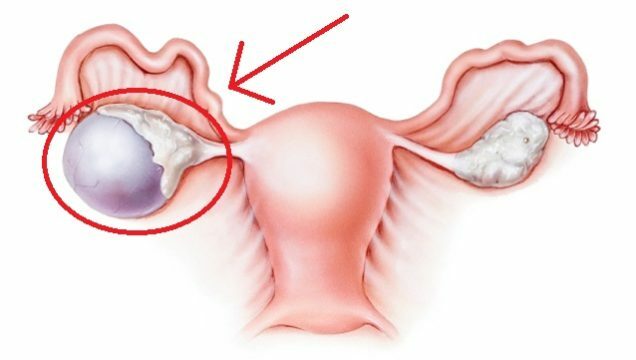Ovarian cysts can occur absolutely in all women in all age categories. In addition to the appearance of various unpleasant sensations, this pathology can threaten women's health and adversely affect conception, that is, it interferes with pregnancy. One of the most common clinical manifestations of pathology is the change in the monthly, that is, the nature of the discharge in the ovarian cyst varies.

What is it?
Very many girls are wondering which particular ovarian cyst should be, and what are the triggers of the disease. Every month in the ovaries( usually alternately) of a healthy woman, the egg is born, which in turn is then placed in a cavity filled with liquid. This cavity is nothing but a follicle, the diameter of which can reach two centimeters.
On the 15th day of the cycle, the follicle bursts, thereby releasing the egg and entering the fallopian tube, where it must be fertilized. In some cases, the follicle does not collapse, and fluid accumulation begins in it. Its dimensions are gradually increasing. This formation is the ovarian cyst.
It is inherently a cystic neoplasm, but it does not belong to oncological processes, since other mechanisms are at the base of the cyst formation: the pathology of growth and development of the follicle, disorders in the yellow body or the inflammatory processes of the ovaries. In the cyst there is a liquid, and she herself can cause certain uncomfortable phenomena to a woman, which depends on various factors - size, appearance and others.
There are several types of cystic formations that are treated differently:
- Endometriosis. Its main feature is the presence of vesicles with blood veins that are located on the endometrium of the uterine cavity;
- Follicular or yellow body. It can appear on any ovary, its size varies from 3 to 8 cm. Usually such formation disappears without any help after several weeks;
- Mucinous. It is a multi-chambered bubble. Such a cyst can grow into a sufficiently large formation, and after a while it can also become malignant, that is, become an oncological process of the ovary;
- Hemorrhagic. This cyst contains blood inside, usually it develops from the ordinary follicular cyst;
- Dermoid. It is a benign neoplasm, on average, its size is 10-15 cm, and inside it contain organic tissues and their elements.
Clinical picture of
Usually an ovarian cyst does not cause any uncomfortable phenomena to a woman, and not always they know about having such a problem. Quite often cysts can disappear in a few menstrual cycles. Primary symptomatology implies that the presence of pathology is detected only at the reception of a gynecologist, since she herself does not manifest herself in any way.

Secondary symptoms of the pathological process can occur after various kinds of stresses, in which there is a twisting or squeezing of the cyst's leg, which provokes the development of pain. In addition, sometimes there is severe blood loss, which is characterized by the irradiation of pain in the vaginal area. Also, among the symptoms of the disease should be noted the following:
- Violation of the regularity of the menstrual cycle;
- Severe and protracted pain during menstruation;
- Sensations of gravity and pressure in the pelvic area;
- Appearance of brown precipitates;
- Delayed monthly.
There are clinical manifestations of pathology, which, in addition to the above symptoms, indicate that it is necessary to immediately seek help from a specialist:
- The appearance of severe dizziness and pronounced general weakness;
- Hyperthermia 38C and above;
- Abundant monthly;
- Polyuria, leading to excessive thirst;
- The voice can become rougher;
- Appearance of hair on the face of the male type;
- The presence of a seal in the abdomen, which can be palpated;
- Weight loss.
What allocation can be
Most women say that when a pathology appears in the appendages of the ovaries, unpleasant feelings accompanied by bloating often quite often develop, and the character of menstruation undergoes significant changes. With irregular periods, and when delays occur, in the case of an ovarian cyst, you can safely say that the disease is progressing.
It should also be noted that the delay in menstruation is a fairly common symptom that is caused by the impossibility of ovulation. The delay can reach a whole month, but it usually lasts about one week.

In the case of the follicular cyst of the yellow body among the features of the monthly, it should be noted:
- Severe tenderness in the lower abdomen and in the sacrum. Quite often this symptom is accompanied by excessive formation and, as a consequence, the escape of gases;
- Increased duration of menstruation, which can last more than a week;
- Increase in the volume of menstruation, which go very intensively throughout the entire period;
- In some cases, scant excretions are noted, which have a close connection with the violation of the hormonal background due to a decrease in the concentration in the blood of female sex hormones, progesterone and estrogens.
Endometriodic cyst has the following features of the course of menstruation:
- One week before the onset of menstruation, there appear mucous discharge of hemorrhagic nature;
- Menstruation itself lasts longer than usual;
- Basal temperature slightly increased;
- Pain sensations during menstruation are greatly enhanced;
- After the end of menstruation, pain can persist and increase after sexual intercourse.
Treatment of pathology
Often the presence of pathological neoplasms implies a long process of treatment, which can last even several months. It is necessary to undergo a full examination with a gynecologist, after which the treating doctor will be assigned the appropriate treatment regimen. Usually, it involves the use of hormonal and anti-inflammatory drugs and is aimed at blocking the work of the ovaries. This allows to slow down the development of formations and prevent the formation of new cysts.
If pathology has been detected at its earliest stages of development, then adequate therapy can get rid of it for about three cycles. Quite often there are blood clots in normal secretions of menstruation, which in their essence are elements of cysts. If conservative therapy does not yield positive results of treatment, and the growth of neoplasms continues, surgical treatment is necessary. Often it is a laparoscopic intervention that is performed during menstruation. During it, a puncture of the yellow body is made, and a liquid is sucked through the resulting hole. After that, the cyst shell must come out in a natural way. The remaining neoplasms are usually removed in parts.
Allocations after laparoscopic surgery
The protocol for the treatment of cystic neoplasms implies the beginning of treatment after 2 months from the moment of its detection. It is prescribed in the case when there is a pronounced tendency to growth of the cyst. Surgical treatment is performed by means of laparoscopic surgery - a fairly gentle method, in which a large incision is not performed, and several small incisions are made, which in the end can not always be even noticed. After performing the intervention, menstruation should occur according to the usual schedule for a woman, however, slight shifts are permissible. Sometimes there are mucous or hemorrhagic discharge( with blood), which are a variant of the norm. Worry should be if there are such discharges:
- Having an unpleasant smell;
- Changed their color to white - probably thrush developed;
- Changed their color to yellow, green or brown. In this case, we can talk about the presence of an infectious process in the body.
It should be noted that the presence of various disorders of the menstrual cycle is an occasion to visit the doctor, because in addition to cystic processes such symptoms can talk about various problems in the female body. Ovarian cysts, in turn, in the absence of observation and treatment can lead to all sorts of complications, among which one of the first places is infertility. That's why you should not delay a visit to a gynecologist.



